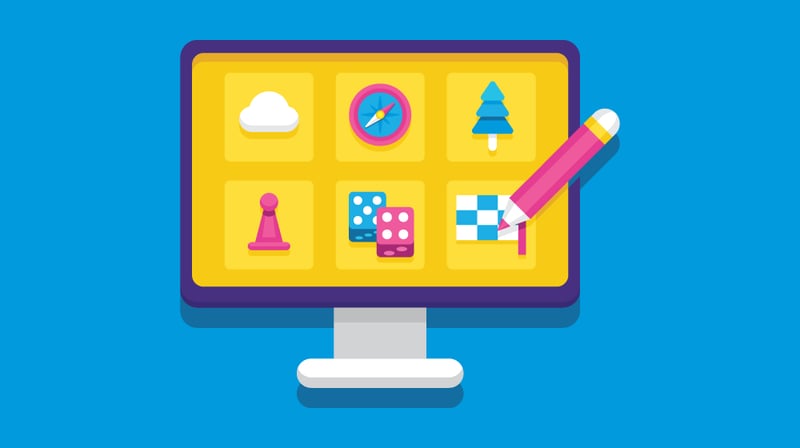As another academic year comes to a close, we begin to shift gears and prepare for next fall.
If you’re like me, this preparation often includes hiring a large team of student employees, which can feel quite daunting.
You may wonder, how can I be more efficient with everyone’s time, both my own and the student applicants? How can I keep everyone engaged and excited while completing this work? And most importantly, how can I create an inclusive hiring process? Well, cue the dynamic group interview experience!
Simply put, group interviews allow you to interview multiple candidates simultaneously. You’ll be able to see how students conduct themselves in a group setting, how they communicate with others, and even what roles they assume. Do they emerge as a facilitator? Do they invite others to contribute? Are they an active listener? Do they make compromises?
Group interviews can be an effective way to hire a large team of students. But the effectiveness of this interview format requires intentionality on your part.
When not planned and facilitated well, a group interview can create uncomfortable and tense environments for your applicants, which can result in an inequitable and inaccessible hiring process. Here are several strategies to ensure an inclusive hiring environment, along every stage of the process — from planning to facilitation and assessment.
Planning
1. Schedule with flexibility in mind
Flexibility and efficiency for your other SApro staff was probably a main motivator for deciding to conduct group interviews. And although I wholeheartedly agree that you should seek to use your own time effectively, I’d like to challenge you to think about flexibility and efficiency from the student perspective too.
Our students are busy — not only with their academics and co-curricular activities, but also with work, families, and community service responsibilities. If you create unintentional barriers to applying or succeeding within the group interview process, students may assume that the position won’t work well for their schedules. So, you need to implement flexibility to promote accessibility. Here’s how:
- Identify a variety of interview dates and times, with options during work hours and in the evening. I also caution against trying to do all of the interviews within a single week. Instead, determine a 2-3 week period when you can offer interview opportunities. Spreading your interviews out allows students to choose a week when they will be able to present their best selves during that interview. If your interview options are all packed into a week that is filled with exams or papers, you can bet you will have students who will bring that energy — or lack thereof — to the interview.
- Make scheduling convenient by using software like Calendly, Simplybook.me, Doodle, or an online system already in use on your campus. Doing so also sends the message to applicants that if something were to unexpectedly interfere with their availability, rescheduling will be easy.
2. Build trust through structure
Calling it a “group interview” makes the process seem pretty straightforward, right? You’ll complete interviews in a group setting.
I wish it was that simple, but to be successful, group interviews need to be highly structured. You should also be transparent with your students about the goals and expectations of the interview. This structure and transparency will build trust between you and the students even before you hire them.
Here as some tactics to consider:
- Begin the interview by explaining to students why a group interview makes sense for this position. Pull up the job description and point to specific responsibilities that relate to the group interview process. For example, if the hired employee will facilitate small group conversation, then tell applicants that the group interview process allows you to see them in action as part of a small group.
- Explicitly state the skills and attitudes you are assessing throughout the interview. Consider creating a rubric or evaluation sheet that you share ahead of time. That way, students will see upfront that they are fairly being assessed along specific position-related criteria, rather than external factors like their GPA, clothing choices, or pre-existing connections to staff in your office.
3. Pick the right activity
The quickest way for group interviews to go haywire is through a generic, disorganized activity. Sure, you could easily do a quick Google search for group activities that evaluate teamwork or communication, but while some of these may happen to be effective, I encourage you to think a bit more creatively and identify a group interview activity that truly aligns with the position you’re hiring for.
I’ll use the example of hiring peer mentors for a first-year seminar course. Peer mentors need to understand diverse experiences and campus resources, be able to share information and tell stories in a professional and personable way, and have strong communication skills.
Based on these key attributes, I designed an activity called the First-Year Top Ten. During the interview, I break students into small groups of 8-10 and task them with identifying 10 experiences that a student on our campus should engage with during their first year. Then, they need to come up with an effective way to “pitch” their recommendations to a group of first-year students.
This activity not only helps me assess the key qualities I am looking for in peer mentors but it’s also not threatening to students. The activity is designed to play to their strengths, allowing the nervousness often associated with interviews to quickly subside and for their leadership and communication skills to shine.
By eliminating “gotcha” interview questions and having an activity that speaks directly to student skills and knowledge, you’ll create an accessible, inclusive interview environment that applicants can thrive in.
Facilitation
4. Know your role
Group interviews are most successful when they are not influenced by facilitators.
As the facilitator, you can feel inclined to speak up whenever there are awkward silences or conflicts. But I encourage you to remain silent and become an observer.
By taking on an observational role, you’ll provide your applicants the opportunity to show you how they will perform their duties unsupervised. How will they act when no one is there to ask pointed questions to or intervene when problems arrive? By observing, you’ll demonstrate that you trust them to use their professional judgement and leadership skills when working independently.
In fact, if you have done a good job structuring the interview and picking an engaging activity, seeing applicants assume the role of facilitator could be a total win! After all, you’re evaluating them on how well they work within group settings, right?
Returning to the theme of transparency and trust, be sure to let the students know what your role is prior to activity’s start. Tell them that you will be observing them and are not there to facilitate or guide the activity in any way.
5. Know when to intervene
Nine times out of 10, your interviews will go off without a hitch. But, every once in a while, the experience can turn toxic. This toxicity can come from small issues like one or two folks monopolizing the activity or from larger issues like discriminatory or othering comments.
To avoid this, set group ground rules. Encourage students to actively listen, include all voices, think critically in hopes of resolving conflicts, and be willing to compromise. To get every applicant on board with the group rules, invite them to add or modify some rules.
Once ground rules are established, be clear about when you might intervene. Naming these instances up front creates a sense of trust between you and the students, along with a culture of accountability. Remember: these students are also interviewing you as a future employer and deciding if they want to join your team.
Knowing when to intervene requires you to watch closely and listen to all interactions. It may be obvious that you would call out blatantly discriminatory comments, but microaggressions can often sneak by in these situations and can cause significant harm to students. If you notice a microaggression, acknowledge it to preserve the trust you have established with the students. Here are some tips you can use to counter microaggressions and redirect the conversation.
6. Invite co-observers
Creating an inclusive group interview process requires fairness, which you can strive for by having multiple people observing and assessing each applicant group Additionally, having additional sets of ears and eyes will increase your likelihood of stomping out toxicity before it gets out of hand.
Co-observers can be your SApro coworkers or other campus faculty and staff who are familiar with your office or program. They could even be student leaders who have previously served in the role you’re hiring for.
No matter who you choose to add to the co-observer team, plan a pre-interview prep session to cover the following topics:
- The activity, the value of group interviews, and how this process aligns with the position and result in a great group of student employees
- The rubric and why you are assessing these qualities and skills
- Roles and expectations for them as an observer (and not a facilitator)
- Microaggressions 101
Evaluation
7. Follow a rubric
Creating your rubric and sharing it at the beginning of each interview will help students trust the process; they’ll see that hiring is being done in an equitable, unbiased way. Additionally, having 2-3 observers complete rubrics for each student ensures objectivity in the selection process.
Students shouldn’t be evaluated on yes-or-no things like “spoke up five times” or “contributed two ideas.” Instead, choose quality over quantity. For example, if I am hiring for an orientation leader, my rubric might look like this:

printable example rubric for evaluating potential orientation leaders
In addition to filling out the rubric, all observers should provide comments or rationalize their scores. These scores and comments should guide your hiring decision and be made available to any candidate who desires feedback once you have made your offers.
Consider including a line in both your offer and rejection letters that reads “we believe that any interview is an excellent learning and professional growth opportunity. If you would like to receive specific feedback on your interview, please know that is available.” This again creates trust in the process.
8. Build in time for feedback and debriefing
I think we can all agree that there is nothing worse than finishing an interview and being “ghosted” — that is, never receiving feedback nor having the opportunity to ask the employer any questions.
So, at the end of the group interview, I recommend building in time to debrief as a group. Whether this is their 10th interview or their very first one, interviews are always an excellent learning experience.
Based on the activity you designed, identify two or three discussion questions that you can pose to the students at the conclusion of the interview. Reflecting on the process will again help them piece together why being evaluated in a group interview setting was valuable.
You can also include time for students to speak with you individually for feedback.
Individual feedback right after an interview can be tricky, as you should be careful not to create false promises of that student being hired. I recommend first ensuring them that detailed feedback from each observer will be available to them following hiring decisions.
Secondly, take a flipped feedback approach. Start by asking the student “what role do you think you played during the group activity?” The student will likely share with you where they excelled and where they need work. Based on their response, you can then provide targeted positive feedback along with suggestions for growth.
This flipped feedback approach is non-threatening, as the student is guiding the conversation and inviting you to provide constructive criticism.
Keeping transparency, flexibility, and trust at the forefront of each stage of the group interview ensures an inclusive, accessible hiring process and an overall positive experience for each applicant. Through your commitment and thoughtfulness in the group interview process, you’ll see long-term results in an effective and engaged student team next academic year.
Relatively, check out these 21 Interview Questions That Reveal A Lot About Potential Student Employees.
What other great tips do you have for group interviews? We’d love to learn from your success. Connect with us on Twitter @HelloPresence and @lindseyggutsch.





